Being in the agriculture industry means dealing with uncertainty, laborious tasks, and decisions that influence production. How can artificial intelligence make this work easier?
In this article, you will explore the benefits that AI brings to agriculture, the real-world applications, the challenges associated with the technology, and its future.
5 benefits of AI automation in agriculture you should know
Advantages of AI adoption are often highlighted in many industries, but what about agriculture? Farmers are already beginning to implement these technologies and are seeing positive results:
- Addressing labor shortages
- Increasing productivity
- Improving decision-making
- Reducing costs
- Helping the industry adapt to climate change.
Let’s take a closer look at each of these benefits.
Addressing labor shortages
For generations, working the land and tending livestock have relied on people. Today, though, farmers face difficulties in finding enough workers.
Over the 15-year period from 2009 to 2024, the amount of agricultural labor steadily decreased. The root causes: a combination of major advances in mechanization and a wider range of attractive employment opportunities in other industries. However, AI in the agriculture market is helping to close the gap.
Autonomous robots, for example, can replace workers in a cattle barn. An AI-powered feeding system can not only calculate how much each animal needs but also deliver the food. The farmer can keep an eye on everything remotely through a smartphone app — no need to hire more workers.
Transforming agriculture, autonomous tractors have the potential to cut down the need for manual labor by as much as 40%, while boosting productivity by 20%. They operate without direct human control, allowing a worker to monitor their progress remotely.
Nowadays, tasks like weeding, seeding, and feeding livestock can be done by automated systems, with farmers mainly supervising the process. Such advancements in the agricultural industry help them cope with labor shortages and make everyday work easier.
Increasing productivity
Modern agriculture faces a pressing challenge: it must boost food production by 60% over the next 25 years to keep pace with a growing population. In this context, how does AI for agriculture help farmers?
First, it gives farmers new ways to check the health and quality of their production. In crop production, it can help detect diseases and pests, or areas under stress. In livestock farming, it can be used to track animal behavior, monitor vital signs, and manage feeding.
Second, it saves time. For example, with a portable device on a pig farm, workers no longer need to spend hours herding animals to the stationary scales and keeping them still. They can measure the weight of an animal even while it’s moving, simply by pressing a button.

Improving decision-making
Every day, farmers face decisions that directly affect both the quality of their production and how their operations run, from when to fertilize to the best time to harvest. With artificial intelligence in agriculture, they don’t need to waste time on unnecessary work and feel stressed about the weather and changing growing conditions.
For instance, an AI-driven weather forecasting model can inform farmers of daily conditions. With hyper-local, real-time weather forecasts, planning agricultural activities becomes much easier.
AI agents are also tools that help farmers make more informed decisions. Trained on data from a specific farm, they can do more than answer broad questions — they can recommend the next optimal steps or adjust watering schedules in real time.
In livestock management, AI can monitor feeding patterns, animal movement, and abnormal behaviors. For example, if a cow doesn't receive enough milk from a feeding system, the farmer gets an alert on his phone. This monitoring helps the worker keep a closer eye on the animal, avoiding unnecessary steps. Therefore, it’s not surprising that the demand for livestock monitoring is increasing: the market is projected to reach $26,98 billion in 2032, up from $8,52 billion in 2025.
Reducing costs
While adopting AI automation in agriculture can require significant upfront investments, the long-term savings are often worth the cost.
Farmers can reduce spending on hiring: In some cases, AI-powered systems can replace half or more of the labor needed for specific tasks. For those who remain, the technology makes the work less physically demanding — as with the portable pig weighing device.
AI is also helping farmers take greater control over water usage, fertilizers, and pesticides, which are among the most costly inputs. Variable-rate irrigation systems apply water only where and when needed; while AI-driven pest monitoring detects specific areas requiring pesticide treatments instead of blanket spraying.
Helping the industry to adapt to climate change
As a climate-dependent sector, agriculture is among the first to feel the effects of climate issues: more severe weather, reduced water availability, and soil degradation. However, AI can help make agriculture both more resilient to climate change — and more sustainable.
One key area is water management. By monitoring water use across the farm, AI-powered systems can help farmers identify where resources are wasted. They also ensure that crops and soil receive exactly the amount of water they need, no more and no less.
AI can also help farmers overcome challenges by providing solutions for soil and crop monitoring, predictive analytics, and pest and disease management. The trend is accelerating. The global precision farming market — valued at $10,43 billion in 2024 — is estimated to reach $27,29 billion by 2035.
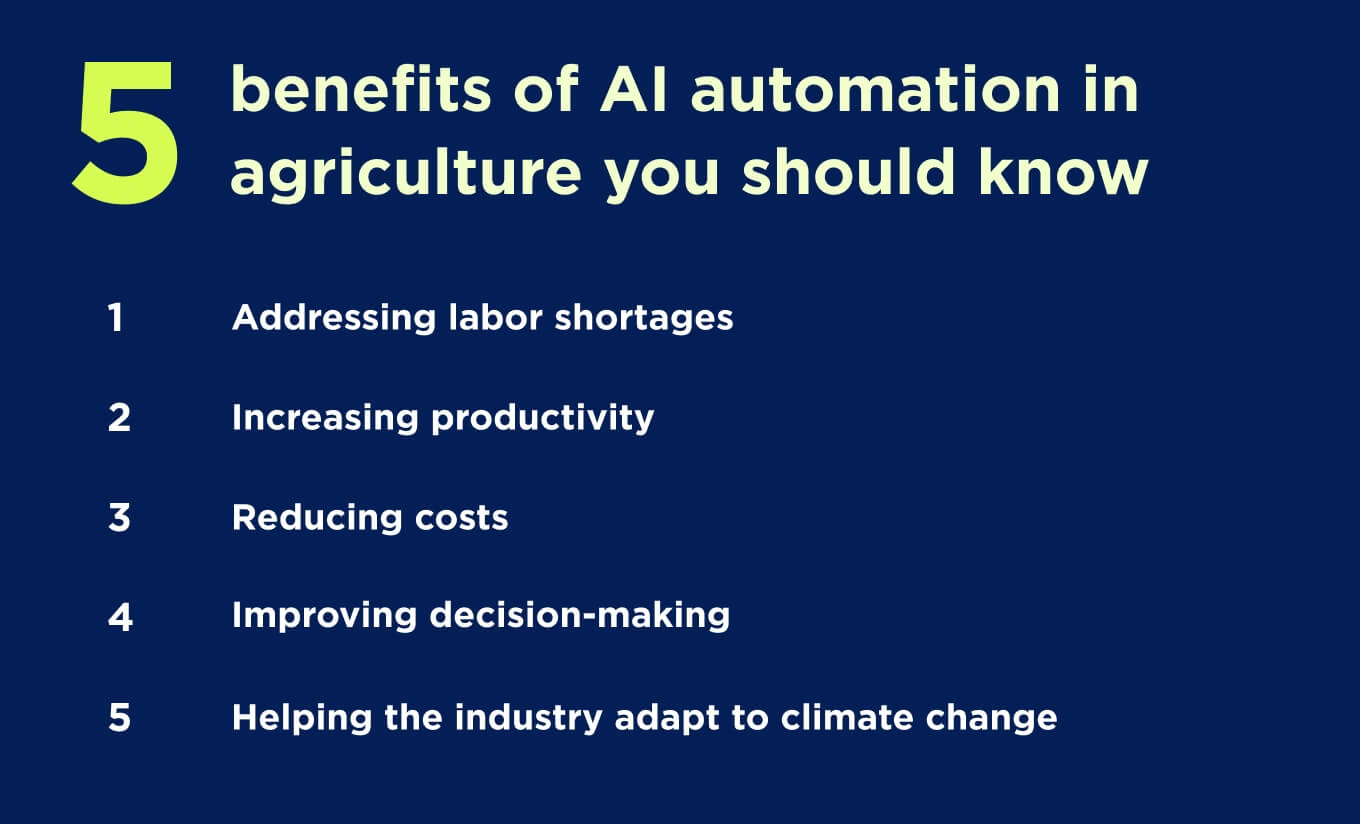
5 real-world examples of AI automation in agriculture
Understanding the benefits of artificial intelligence in agriculture gives a general idea of what the technology can offer. But real-world examples provide a clearer picture. Let’s take a look at some of them.
Pig weighing automation for a pig farm
On a pig farm, one of the most labor-intensive tasks is weighing the animals, a critical step in ensuring they meet the precise weight requirements of many markets. Traditionally, many farms have used stationary scales for this purpose. This method typically requires two or three workers to herd each pig and hold it still long enough for an accurate measurement.
Barkom, a Ukrainian agriculture company, was no exception. As much as the farm would like to automate this job for its workers, it simply cannot find available options.
“Any large device is challenging to use on the farm. That’s why the solution needed to be compact and able to work in harsh conditions,” says Lou Dutko, Chief Technology Officer at Lemberg Solutions.
The game-changer for the farm was the first-of-its-kind device our engineering team designed, combining its expertise in AI and agriculture.
With this portable system, the farm has cut the time required for weighing animals by 24 times — a significant amount of time. The workers no longer need to herd animals or hold them still; they simply point the device above a pig, press the button, and get the results on the device’s screen. The solution can be integrated into the existing farm infrastructure and with third-party livestock weighing systems.
To make this device work, Lermberg Solution’s team developed an advanced weight recognition algorithm that uses neural networks with a custom image recognition algorithm. Then, engineers tested the solution with almost 17TB of real data.
“Our client said there’s a huge difference for workers in both time and effort. The system delivers 98% accuracy, even when animals move,” explains Lou Dutko.
Here’s how the portable device for pig weighing works:
- A farm worker points the device above a pig
- A built-in camera captures a high-quality 3D image. If there is an issue with a pig in the image, the device notifies the user, allowing them to retake it
- Once the picture is taken, the device processes the image
- In 8-10 seconds, the estimated weight is displayed on the device screen.
Germination analysis device
While seed germination analysis is one of the most time-sensitive processes in greenhouse farming, computer vision technology offers faster, automated alternatives.
The worker places seedlings into the computer vision-based device, which uses high-resolution cameras to capture detailed images of the plants. These images are then analyzed by smart algorithms; the system focuses on detecting the emergence of the first “true” leaf — a key indicator of successful germination. Based on this, the software delivers an instant assessment of germination quality, removing the need for manual inspection.
In addition to germination analysis, the system is capable of early detection of pests and diseases. This allows growers to take proactive measures before visible symptoms appear. With a simple touchscreen, workers can monitor plant health and assess seeding development — all in real time.
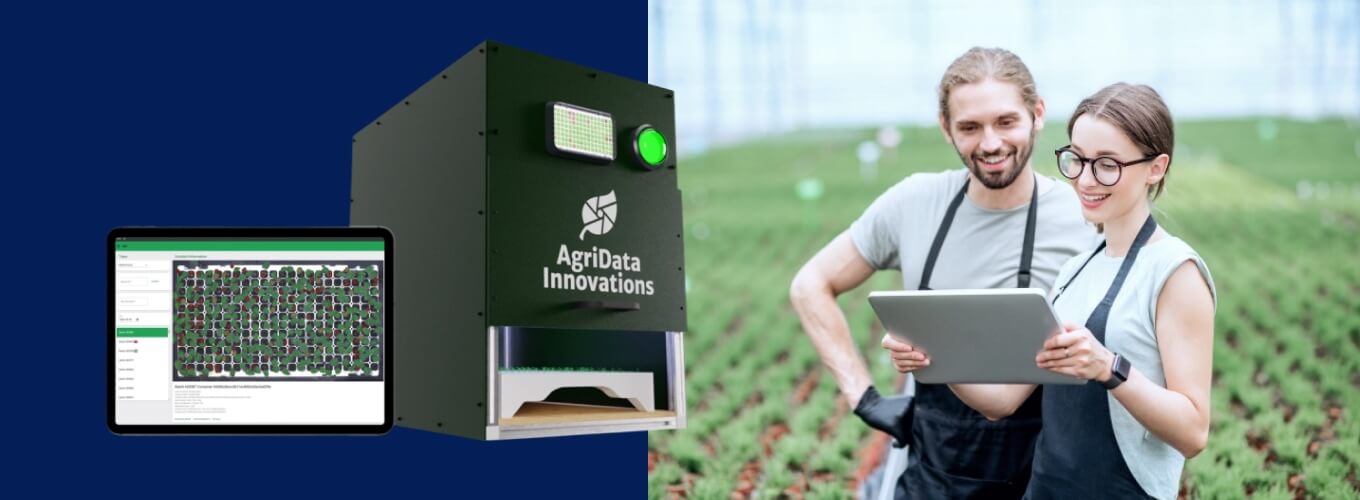
Smart crop monitoring with a smartphone
As precision agriculture continues to spread, farmers can analyze grain quality at any time, either in the field or at storage facilities, without needing to go to a laboratory.
With a computer vision-based mobile app, they can easily select the type of analysis they need, take a photo of the grain sample, and receive instant results on their smartphone or desktop. Behind the scenes, neural networks compare the image against a vast grain database to assess quality in real time. The system works even without a stable internet connection, and previous results remain accessible.
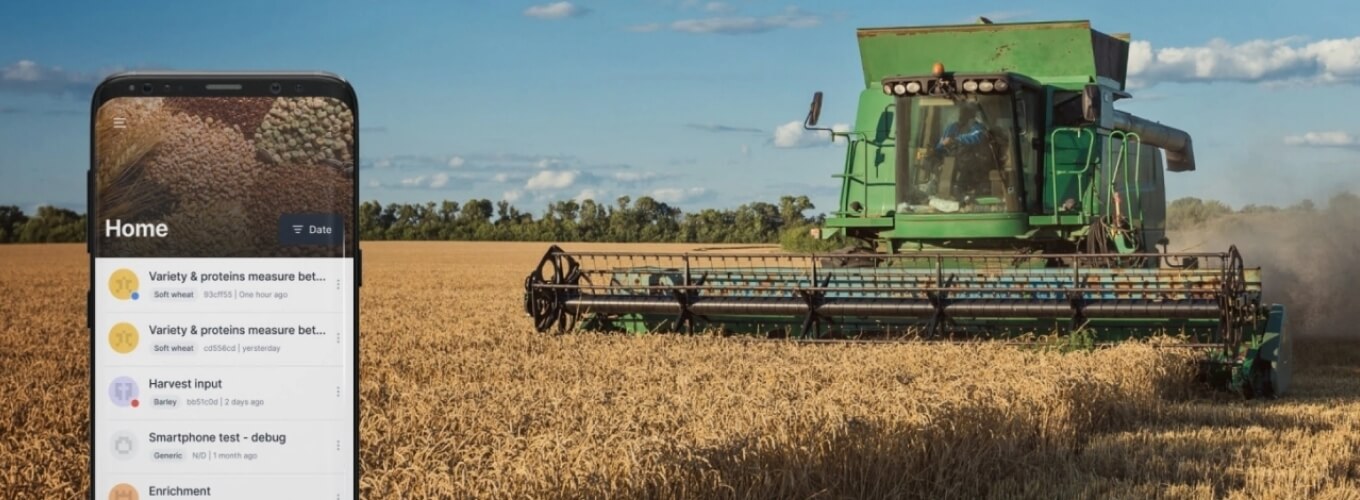
Hygiene monitoring system
In livestock farming, agritech can greatly improve biosecurity while maintaining existing hygiene procedures. For instance, a hygiene monitoring system can utilize beacons and smartwatches in changing rooms and showers to ensure that employees adhere to proper changing protocols. The collected data is presented on a dedicated web dashboard, enabling farm managers to monitor compliance with hygiene standards and take corrective actions when needed.
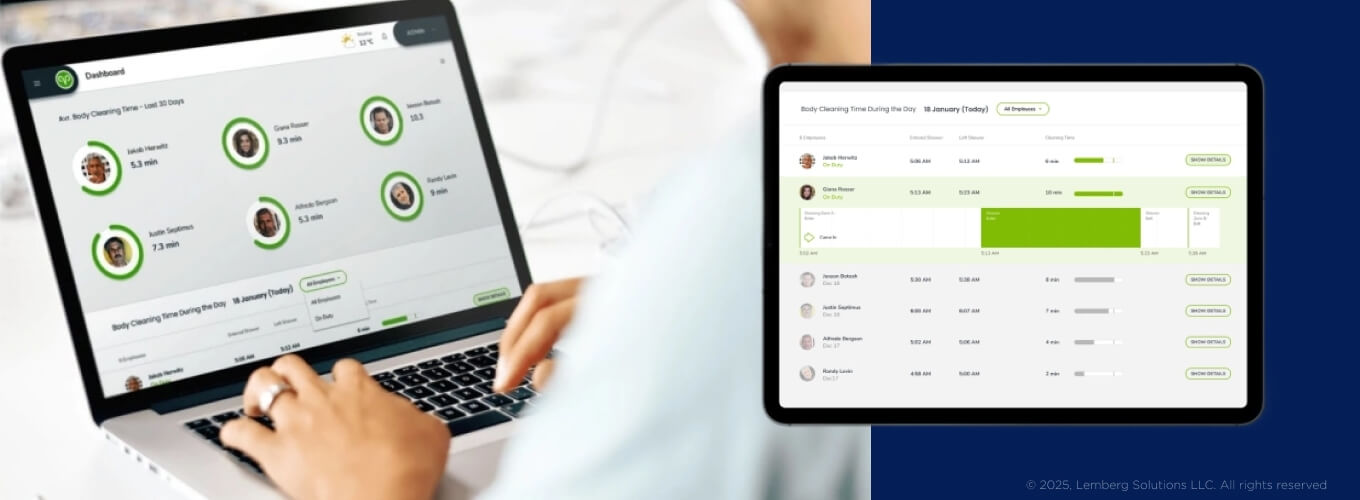
Autonomous tractors
Autonomous tractors are another example of advancements in the agricultural industry. These machines have advanced sensors and AI that optimize water and fertilizer distribution across the field. Farmers can often monitor their tractors from smartphones and receive alerts if anything goes wrong. Plus, live video provides the possibility to view the tractors’ activity in real time.
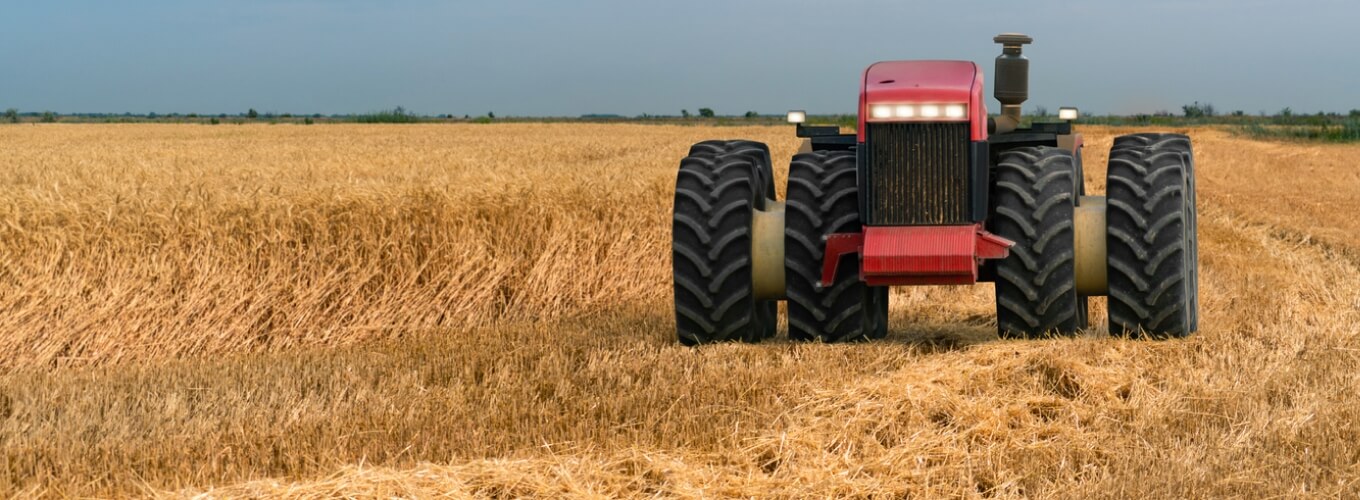
Challenges of AI in agriculture
Even with plenty of examples showing how AI is helping farmers, there are still barriers holding many back from adopting it.
In one survey, farmers from France, Germany, and the Netherlands said they were hesitant to invest in agtech — mainly because they weren’t sure it would pay off. That contrast becomes clear when you look at adoption rates in other regions. The same survey found that 74% of farmers in the U.S. and 53% in Brazil use precision agriculture technologies, compared to 46% in Europe.
This brings us to the broader issue — the common challenges that still prevent wider usage of artificial intelligence in agriculture:
- Costs of initial investment. While major players in agriculture might not feel the strain of investing in AI, smaller farms often face financial barriers. That matters, especially considering there are 9,1 million farms in the EU, with an average size of 17 hectares. For smaller farms, adopting AI raises a long list of questions: “How can I afford this investment? Are there hidden costs? What about maintenance?” These doubts can delay decisions, especially when the work still gets done without any AI tools.
- Uncertain returns. Concerns about cost are closely tied to uncertainty around return on investment. Many in the agricultural sector might be unsure when — or if — they’ll see the benefits of adopting AI for agriculture. Some may have heard of unsuccessful implementations, particularly involving complex systems that didn’t deliver as expected. Moreover, the unpredictable nature of agriculture itself can affect how well AI tools work. Farmers don’t have time to experiment: the cost of a failed season is simply too high.
- Data quality and availability. This is the challenge common to AI implementation in any industry, and agriculture is no exception. Issues like inconsistent data sources, missing information, or a lack of standardization can slow down progress. Farmers may worry that messy or incomplete data will take too much time to fix, resulting in time-consuming and expensive development or implementation of an AI tool. But in reality, these issues are often easier to solve than they seem. For data engineers, ensuring the quality of data is a regular part of their job.
- Training and education. It’s not enough to implement AI — workers also need to know how to use it. On smaller farms in particular, there’s often a lack of staff with the skills or confidence to work with new tools. And even when training is available, adapting to a new system takes time, something farmers can rarely free up.
- Ethics and regulatory oversight. As with any emerging technology, the agricultural industry faces big questions about its impact. Will automation replace those who still want to work on the land? Will not only large agricultural companies, but also smaller players, be able to adopt new technologies? Can regulations effectively address concerns about data privacy and security? These discussions create a sense of uncertainty that often holds farmers back from adopting AI.
What is the future of artificial intelligence in agriculture
Despite the challenges, the need for higher productivity and the shift toward sustainable farming drive farmers to use advanced tools and systems. The global smart agriculture market is predicted to increase from $17.74 billion in 2024 to $38.86 billion by 2031. Meanwhile, AI in the agriculture market is projected to reach $4.7 billion by 2028, up from $1.7 billion in 2023.
“It’s a tendency we also see among our clients. More and more are looking for ways to implement AI, whether to save working hours or to cope with labor shortages. The future of farming is closely linked to this technology,” says Lou Dutko.
Farmers are turning to motion detection technology to spot abnormal animal behavior before it leads to serious issues. They are also looking for real-time livestock monitoring solutions: better insights mean better productivity. Automating inventory management allows farmers to save time on daily tasks. And with AI agents’ popularity across other industries, agriculture is beginning to use these tools as well, for better farm management.
While adapting new technology might seem daunting, that’s not the case with Lemberg Solutions. With over 15 years of experience in agritech, we’ve delivered projects that have changed the way our clients — and their customers — work, from the portable device for the pig farm to the germination analysis solution.

FAQ
Where to begin with AI implementation?
You don’t need highly specific requirements to start implementing AI in agriculture. At the beginning, it’s enough to tell your tech vendor what challenge you want to solve. After discussing the details and asking additional questions, the vendor will propose a suitable solution. From there, the process moves into development and testing. Throughout these phases, you’ll see how the solution adapts to meet your needs.
Can the developed solution be tested in the field?
Testing the solution in real conditions is an essential part of how we work with our agricultural clients. We want to be sure that everything performs as it should in their working environment.
What does AI do in farming?
AI is revolutionizing farming by automating manual tasks and increasing productivity. In livestock farming, AI-powered systems help feed animals, monitor their behavior, and ease the weighing process. For example, a portable device for pig weighing can save 24 times less time on measuring the animals, not to mention how it makes the job easier. In crop production, AI tools support soil monitoring and analysis, plant disease identification, and water consumption management.
Is AI allowed in organic farming?
Yes, AI is allowed in organic farming. Farmers use various AI tools to automate laborious tasks, increase productivity, and support more sustainable farming practices. These tools include pest monitoring systems, AI-powered drones, and autonomous robots.
What type of AI is used in agriculture?
Depending on the goal, agriculture uses different types of AI, including computer vision-based devices, AI-driven robots, and generative AI models. Drones equipped with AI-powered cameras, as well as autonomous and semi-autonomous tractors, are becoming more common in the industry. Sometimes, it’s not large systems but mobile apps, like the one for crop analysis, that farmers can use right from their smartphones.
Can agriculture be fully automated?
While agriculture can be significantly automated, there’s still a long way to go, especially for smaller farms that face challenges like the high cost of AI implementation. Whether the full automation is possible depends not just on replacing manual tasks, but also on replacing the oversight and expertise people bring to the job. Ethical concerns and regulatory rules can also come into play, making full automation unlikely to happen in the near future.


